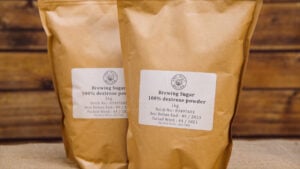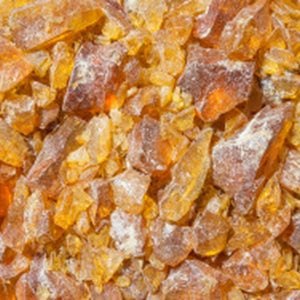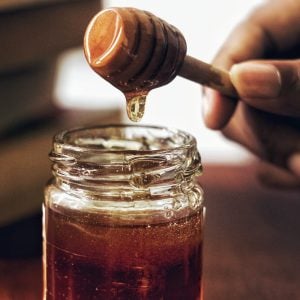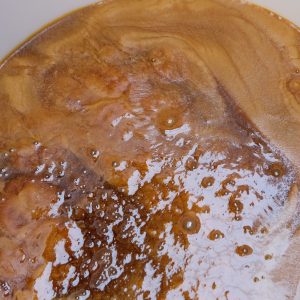Brew With Us ESSENTIALS – sugars and malt extract

Sugar, we’re going down
Yeast needs sugar to make beer!
When we mash, we’re extracting the sugar from the malt to give the yeast something to eat.
But mashing isn’t the only way to get sugar…
Sugars are sometimes looked down on in all-grain brewing, as if adding sugar is somehow cheating. But many kinds of sugars are used in both traditional and modern styles of brewing.
A sugar like dextrose (corn sugar) is a treat for yeast. It’s “simple” at a molecular level, so it’s very easy for yeast to ferment, and it doesn’t add much flavour in small amounts. This makes dextrose ideal for priming bottles for carbonation. Larger amounts of dextrose can taste cidery, so this is where other sugars are useful.

Outside bottle priming, the typical use of sugar is to add strength and body to beer. A readily accessible source of simple sugars will get your yeast growing quickly. In a straightforward ale, this healthy yeast means you are more likely to get a good dry finish – that’s right, adding sugar can make your beer less sweet. The same is true when you want to brew a strong beer like a double IPA. Giving the yeast something easy to start with can help make sure you reach your target level of alcohol, otherwise the yeast might give up before it’s got through all the malt. Yeast can be a bit lazy!
You can use this laziness to your advantage to go the other way and add sweetness and body to a beer. Yeast will always munch through simple sugars before it goes after complex malt sugars. Yeast can also only consume so much, so if you build a recipe with complex malts and some simple sugar, your yeast will get “full up” on the simple stuff and leave the complex stuff over, adding body and fullness. So in this case, the sugar you’re adding might add some sweetness – but the sweetness doesn’t come from the sugar, it’s from malt (mindbending stuff, we know!).
Brewing sugars

Candi sugar is ideally suited to this sort of bodybuilding and you’ll find it in all sorts of Belgian styles. Candi sugar is a little more “complex” than dextrose but still easy for yeast to consume, and it tastes much better in larger amounts. Candi sugar comes as crystals (rocks) in different colour grades, from light to dark, with the darker rocks having a deep flavour similar to dried fruit.
Invert sugar or “brewer’s invert” is used in historical British ales and can be made by heating plain sugar on your stove to specific temperatures or by blending golden syrup with black treacle or molasses in varying degrees. As well as being useful for adjusting the colour of a beer, these invert sugars add rich flavours that can’t be duplicated with malt alone.
Honey is an obvious source of sugar and honey beers are readily found. Like the other sugars here, adding honey won’t necessarily make your beer taste sweet, as the yeast will eat the sweeter simple sugars first. Instead, honey adds distinct floral and fruity flavours. High quality honeys can contain wild yeasts, so often honey is added in the boil to kill these off, though this will also remove some of the more delicate flavours. Adding raw honey to the fermenter gives more flavour but carries the risk of spoiling the beer from the wild yeasts.

Unfermentable sugars
Some sugars are so complex that regular yeasts can’t ferment them at all. Lactose (milk sugar) is unfermentable for the majority of brewing yeasts, so you can use it to add sweetness without any extra fermentation. It has a signature milky flavour that works well in stouts, but be mindful that some people are lactose intolerant and even small amounts can upset their stomachs.
Maltodextrin is another less fermentable sugar that doesn’t have the intolerance issues of lactose. In small amounts, it adds a rich, malty body to beer, and is much less sweet than lactose. Too much can taste like wallpaper paste, though, so be careful!
Malt extract

Malt extract is basically pre-made wort that’s been reduced to a syrup. You can buy this as liquid malt extract, or LME. The syrup can be dried into a powder for easier storage by spraying a thin layer across a large surface; hence dried malt extract (DME) is also known as spraymalt.
Malt extract is useful throughout the brewery. Diluted back into wort, it’s an ideal food source for growing and culturing yeast, since it’s nutritionally identical to real beer. By the same token, you can use malt extract to add strength to a weaker beer – for example, if you missed your target gravity or you just don’t have capacity in your system for a larger amount of grain. You can also make excellent beer using just malt extract. It’s wort, just the same as if you start from grain!
There’s an increasingly large range of malt extracts available, made to different colour grades and from different malts. You can also now get soured malt extract, which you can use either like acidulated malt to adjust mash pH, or to make sour beers without risking the use of bacteria or specialty yeasts. Modern extracts are very high quality and can definitely find a place alongside grain in your recipes.
Let’s loop back…
As we come to the end of our malt marathon, we’ll review everything we’ve learned – and how to use that knowledge for good (beer)!


